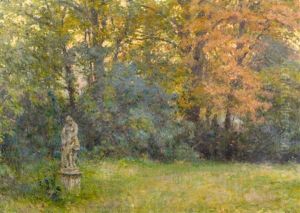Alfred Nathaniel Oppenheim Paintings
Alfred Nathaniel Oppenheim was a British artist whose life spanned the turn of the 20th century, a period known for significant changes in the art world. Born in 1873, Oppenheim's career unfolded during a time of transition and innovation, as artists sought new ways to express the rapidly changing world around them. Although not as widely recognized as some of his contemporaries, Oppenheim contributed to the art scene with his unique perspective and stylistic experiments.
Oppenheim's artistry was primarily rooted in the traditional, but he was influenced by the burgeoning movements of his time, such as Impressionism and Post-Impressionism. His work often depicted scenes of everyday life, landscapes, and portraits, characterized by a keen attention to detail and a subtle use of color. Despite the dominance of more modernist movements in the art world, Oppenheim remained committed to his style, which resonated with a sense of calmness and contemplation.
Throughout his career, Alfred Nathaniel Oppenheim exhibited his work in various galleries and shows, though he never achieved the level of fame or recognition that some of his peers did. His dedication to his craft, however, was unwavering, and he continued to paint and exhibit until his death in 1935. Today, Oppenheim's work is appreciated for its quiet beauty and the glimpse it offers into the life and times of the era in which he lived.
Oppenheim's legacy, while modest in comparison to the giants of his era, is a testament to the diversity of artistic expression during a period of profound change in the art world. His paintings serve not only as artistic expressions but also as historical documents, capturing the nuances of a world on the cusp of modernity. In the end, Alfred Nathaniel Oppenheim's contribution to the arts lies in his steadfastness to his vision, offering a counterpoint to the prevailing trends of his time and enriching the tapestry of early 20th-century British art.

















